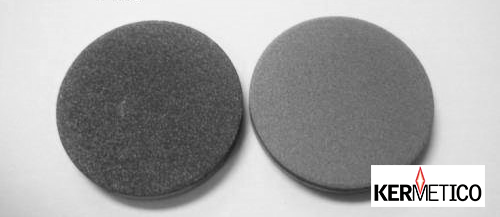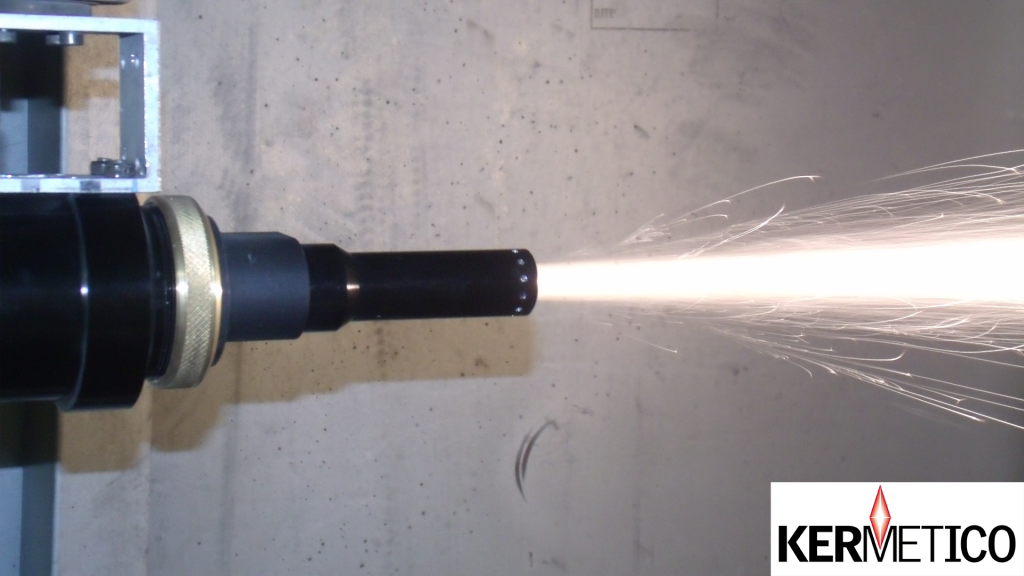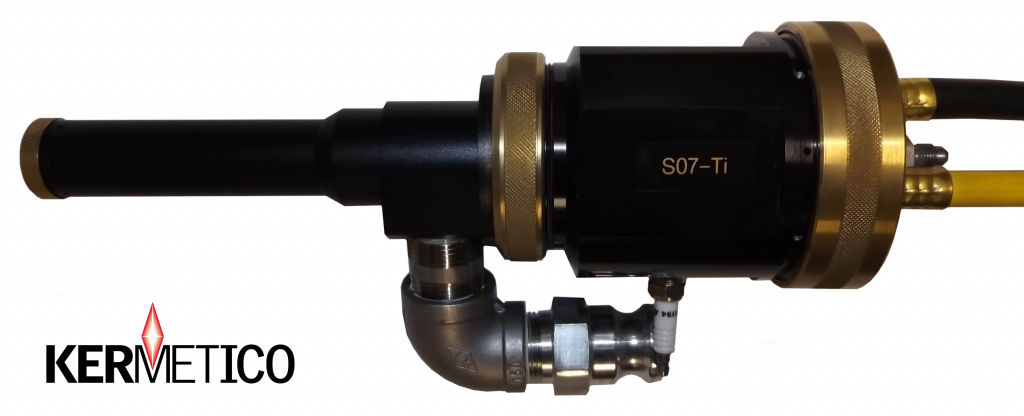We have designed this gun to thermal spray Ti alloy and titanium coatings in the air. The STi system allows repairing titanium alloy parts.
Key features:
- High-velocity thermal spray titanium coatings in the air in an inert gas shroud
- Low level of oxidation, silver-like coating appearance
- Dense coating
- For corrosion resistant coatings and material build-up
The STi system is one of our latest developments, and we are still researching its possibilities.
The following text demonstrates the possible fields of interest for this system to be used in application research and development.
We will be glad to study it in depth together with a corporate or scientific lab.
Properties of Our Sprayed Ti Alloy and Titanium Coatings
The two most useful properties of titanium are corrosion resistance and the highest strength-to-density ratio of any metallic element.
In its unalloyed condition, titanium is as strong as some steels but less dense.
Like aluminum and magnesium, titanium metal and its alloys oxidize immediately upon exposure to air.
Titanium readily reacts with oxygen at 1,200°C | 2,190°F in the air, and at 610°C ] 1,130°F in pure oxygen, forming titanium dioxide.
It is, however, slow to react with water and air at ambient temperatures because it forms a passive oxide coating that protects the bulk metal from further oxidation.
When it first forms, this protective layer is only 1–2 nm thick but continues to grow slowly; reaching a thickness of 25 nm in four years.
Atmospheric passivation gives titanium excellent resistance to corrosion, almost equivalent to platinum, capable of withstanding attack by dilute sulfuric and hydrochloric acids, chloride solutions and most organic acids. However, titanium coating is corroded by concentrated acids.
Titanium Spray Coating Applications
Thanks to it’s high resistance to corrosion by sea water, titanium and its alloys are used to make:
- propeller shafts
- rigging
- heat exchangers in desalination plants
- heater-chillers for salt water reservoirs and aquariums
- aerospace parts
Titanium and its alloys are used in the housings and components of ocean-deployed surveillance and monitoring devices for science and the military.

A Titanium Coating has been Deposited onto the Left Substrate by Our AK7, onto the Right One – by Our STi
Titanium is not an easy material to spray. It reacts with oxygen and nitrogen at relatively low temperatures.
That is why most of the developers were trying to deposit it with a vacuum or an inert gas atmosphere.
These approaches make the coating extremely expensive.
We have chosen a different approach, creating an inert atmosphere inside the high velocity thermal spray gun.
Hard to believe?
But it is true.
The particular design of this unique thermal spray system keeps Ti powder in the inert gas atmosphere all the way through the thermal spray gun until it meets the substrate and bonds there.

The Kermetico STI High Velocity Thermal Spray Gun Spraying Pure Titanium in the Air
Thermal Spray Restoration of Worn-out Titanium Alloy Parts
Titanium alloys are widely used in aircraft, ships, and spacecraft due to their high tensile strength to density ratio, high corrosion resistance, fatigue resistance, high crack resistance and ability to withstand moderately high temperatures without deformation.
For these applications, titanium is alloyed with aluminum, zirconium, nickel, vanadium, and other elements to manufacture a variety of components including critical structural parts, fire walls, landing gear, exhaust ducts (helicopters), and hydraulic systems.
In fact, about two-thirds of all the titanium produced for use in aircraft engines and frames.
Many attempts have been made by different research bodies to repair titanium alloy parts with cold spray, laser cladding, and other techniques.
Most of them have failed and had to resort to applying alternative materials onto the worn areas.
As far as we know, the question of restoration of titanium parts is still open.
With the specialized titanium STi system, we can propose the instrument for high-quality titanium alloy coating applications.
The HVAF Titanium Spraying Process Description
The HVAF STi Gun sprays powders, heated and accelerated by the air-fuel gas combustion products.
The mixture of compressed air and the fuel gas flows into the combustion chamber through the orifices of a catalytic ceramic insert.
Initial ignition of the mixture results in heating of the insert above the mixtures’ auto-ignition temperature and then the hot insert continuously ignites the mixture.
When entering the gun, the compressed air cools the chamber and the nozzle assembly.
Then part of the preheated air is mixed with the fuel and combusted.
The spray powder is injected axially into a wide combustion chamber.
The Ti powder exiting the chamber is propelled into the nozzle of the chosen length and configuration where it is accelerated to a velocity that may be over 1,000 m/s (3,300 ft./sec.)
When impacting a substrate, the spray powder particles form a titanium coating.
Kermetico HVAF Thermal Spray Coating Equipment
We design and manufacture three families of HVAF thermal spray equipment.
- Convertible HVOF and HVAF equipment:
- Multi-purpose HVAF AK systems, with a variety of spray guns:
- AK7 – a high power gun for the thermal spray of large parts
- AK6 – a universal gun to spray a balanced mix of parts in a job shop
- AK5 – a compact gun to spray smaller parts, thin walls and complex surfaces
- AK-ID – an 88 mm (3.47”) and larger internal diameter spray gun
- AK-IDR – a rotating ID gun to spray 4” (100 mm) and larger bores
- AK-HH – a handheld gun for on-site coating
- Specialized HVAF S equipment:
- Additional equipment:
- An HVAF grit feeder for the grit blast preparation of parts to reduce coating costs
- A Gas Permeability Tester for an instant check of a coating’s through porosity
Kermetico Inc. – HVAF and HVOF Equipment Design and Manufacture Since 2006
We make different spray guns for different applications.
Please check the full spectrum of our equipment here.
Our HVAF and HVOF systems operate each of our guns or multiple guns at once (by request).
We supply two types of control consoles and a variety of powder feeders and gas vaporizers.
We proudly design and produce our HVAF and HVOF thermal spray equipment in California, USA, and install it all over the world.
You can visit our R&D center in Benicia, CA to meet our designers and to see our HVOF and HVAF equipment in action.















